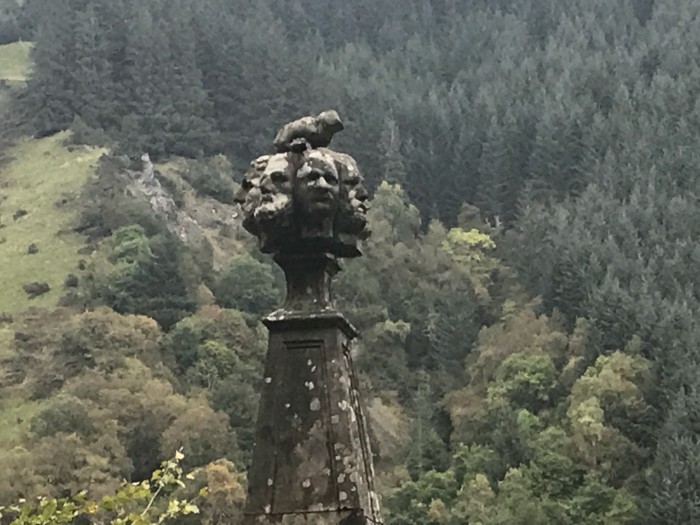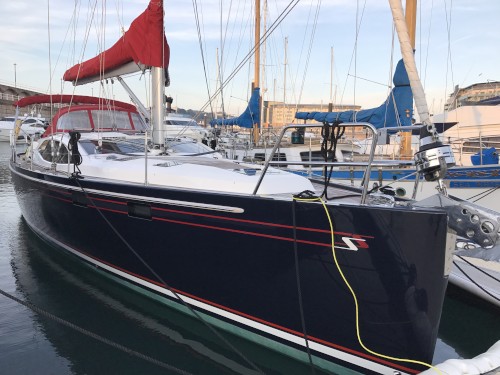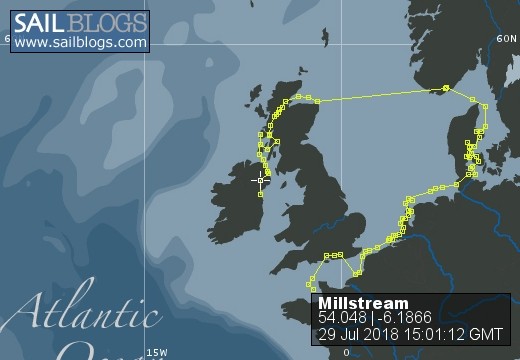
The Voyages of Millstream
29 June 2018 | Malahide
28 June 2018 | Carlingford
27 June 2018 | Portaferry
26 June 2018 | Ringhaddy
26 May 2018 | Carrickfergus
25 May 2018 | Glenarm
23 May 2018 | Colonsay
22 May 2018
21 May 2018 | Port Ellen
20 May 2018 | Campbeltown
03 April 2018
11 October 2017
10 October 2017
09 October 2017
30 September 2017
29 September 2017
28 September 2017
27 September 2017 | Loch Oich
26 September 2017 | Fort Augustus
Day 81 - Fort Augustus to Well of the Seven Heads, Loch Oich
27 September 2017 | Loch Oich

We had to wait for boats coming down the locks before we could enter, but we let go just before 10am and headed through the swing bridge to the first lock. An hour and half later we reached the top of the flight, having been photographed by numerous Japanese tourists, who clearly had no embarrassment at focusing on us at close range.
After lunch we carried on towards Kytra lock and then Cullochy lock.
We tied up for the evening on the pontoon at the 'Well of the Seven Heads' in Loch Oich. There a monument on the banks of the loch to commemorate a grisly tale!
The tall needle-like monument is topped by a sculpture of a hand holding a dagger and seven severed heads - a stark reminder of one of the most gruesome episodes in Scottish clan history.
Warfare among the clans was commonplace in the 16th and 17th centuries but this was a bloody tale of internal strife among different sections of one of the largest clans in the Highlands, the Macdonalds. What is striking about the story of the Well of the Heads is the overwhelming sense of vengeance and power masquerading as justice which typified the clan system and over which the authorities in Scotland had no control.In somewhat typical Highland fashion the story begins with a fight which got out of hand.
On 25 September 1663, Alexander, the 13th chief of the Keppoch family, powerful members of the Macdonalds, and his brother Ranald were killed by their cousins at a brawl in the mansion of Insch, just outside the village of Roybridge. The two Keppoch men had just returned from schooling in France and had thrown a rather grand party. One theory behind the argument is that their cousins began mimicking their French accents and mannerisms and the situation escalated. Others claimed the killers had been set up by more prominent members of the clan to rid them of an unpopular, reforming clan chief. Whatever the truth, the upshot was that two leading clan members lay dead.
The killers were well known, Alexander Macdonald and his six sons from Inverlair, near Roy Bridge.
They had been engaged in an argument with the Keppochs over a piece of land, which undoubtedly contributed to the killings, but in a part of the country dominated by the Macdonalds they had many sympathisers, particularly among "ordinary" people who regarded the Keppoch boys as "gentry". Time passed and no justice was meted out.
But vengeance brewed within one man, Iain Lom, or Bald Iain, a kinsman of the victims and an important figure who held the title of Gaelic Poet Laureate of Scotland. He was known locally as the Keppoch Bard. Bald Iain embarked on a seeming one-man crusade to make the Macdonalds at Inverlair pay for what had happened. He first approached a fellow clansman, Lord Macdonell of Glengarry and Aros, who at the time was regarded by the Scots Privy Council as High Chief of the Clan Donald. But Macdonell did not want to get involved.His next stop was Sir James Macdonald of Sleat but he too was hesitant to become involved in the affairs of a fellow tribe. But Bald Iain had a trump card up his sleeve. The two murdered men had been fostered with Sir James at Duntulm Castle on the Isle of Skye. The vengeful Bard travelled to the castle and appealed to the chief's emotions in dramatic and biblical language.
"Abel is cold and his blood is crying in vain for vengeance. Cain is hot and red-handed and hundreds are lukewarm as the black goat's milk," Bald Iain told Sir James. His ploy was successful. Sir James applied to the Privy Council in Edinburgh which issued letters of "fire and sword" against the killers. Sir James' brother Archibald - the Warrior Poet - was put in charge of 50 men who were sent to avenge the killings of two years previously. Bald Iain was there to guide them to the Macdonald home at Inverlair where, after a brief struggle, the seven known killers - and probably more - were murdered and decapitated. Severed heads The Bard was satisfied; he had his revenge and he wanted to prove it. He wrapped the severed heads in his plaid, tied them together with willow rods and set out for Glengarry.
Before presenting them to Lord Macdonell at Invergarry Castle, Bald Iain stopped to wash them in the waters of Loch Oich, at the site where the grim obelisk now stands. The heads were then sent to Edinburgh where they were "affixit to the gallowes" between Edinburgh and Leith. The monument at the side of the A82 road was erected in 1812 by the then chief of the Clan Macdonell.
The story was by this time verified by the exhumation of a mound on the lands of Inverlair, close to where Tulloch Station on the main Glasgow to Fort William rail line now stands. The mound revealed at least seven headless corpses. Bald Iain had got his bloody vengeance after all.
After lunch we carried on towards Kytra lock and then Cullochy lock.
We tied up for the evening on the pontoon at the 'Well of the Seven Heads' in Loch Oich. There a monument on the banks of the loch to commemorate a grisly tale!
The tall needle-like monument is topped by a sculpture of a hand holding a dagger and seven severed heads - a stark reminder of one of the most gruesome episodes in Scottish clan history.
Warfare among the clans was commonplace in the 16th and 17th centuries but this was a bloody tale of internal strife among different sections of one of the largest clans in the Highlands, the Macdonalds. What is striking about the story of the Well of the Heads is the overwhelming sense of vengeance and power masquerading as justice which typified the clan system and over which the authorities in Scotland had no control.In somewhat typical Highland fashion the story begins with a fight which got out of hand.
On 25 September 1663, Alexander, the 13th chief of the Keppoch family, powerful members of the Macdonalds, and his brother Ranald were killed by their cousins at a brawl in the mansion of Insch, just outside the village of Roybridge. The two Keppoch men had just returned from schooling in France and had thrown a rather grand party. One theory behind the argument is that their cousins began mimicking their French accents and mannerisms and the situation escalated. Others claimed the killers had been set up by more prominent members of the clan to rid them of an unpopular, reforming clan chief. Whatever the truth, the upshot was that two leading clan members lay dead.
The killers were well known, Alexander Macdonald and his six sons from Inverlair, near Roy Bridge.
They had been engaged in an argument with the Keppochs over a piece of land, which undoubtedly contributed to the killings, but in a part of the country dominated by the Macdonalds they had many sympathisers, particularly among "ordinary" people who regarded the Keppoch boys as "gentry". Time passed and no justice was meted out.
But vengeance brewed within one man, Iain Lom, or Bald Iain, a kinsman of the victims and an important figure who held the title of Gaelic Poet Laureate of Scotland. He was known locally as the Keppoch Bard. Bald Iain embarked on a seeming one-man crusade to make the Macdonalds at Inverlair pay for what had happened. He first approached a fellow clansman, Lord Macdonell of Glengarry and Aros, who at the time was regarded by the Scots Privy Council as High Chief of the Clan Donald. But Macdonell did not want to get involved.His next stop was Sir James Macdonald of Sleat but he too was hesitant to become involved in the affairs of a fellow tribe. But Bald Iain had a trump card up his sleeve. The two murdered men had been fostered with Sir James at Duntulm Castle on the Isle of Skye. The vengeful Bard travelled to the castle and appealed to the chief's emotions in dramatic and biblical language.
"Abel is cold and his blood is crying in vain for vengeance. Cain is hot and red-handed and hundreds are lukewarm as the black goat's milk," Bald Iain told Sir James. His ploy was successful. Sir James applied to the Privy Council in Edinburgh which issued letters of "fire and sword" against the killers. Sir James' brother Archibald - the Warrior Poet - was put in charge of 50 men who were sent to avenge the killings of two years previously. Bald Iain was there to guide them to the Macdonald home at Inverlair where, after a brief struggle, the seven known killers - and probably more - were murdered and decapitated. Severed heads The Bard was satisfied; he had his revenge and he wanted to prove it. He wrapped the severed heads in his plaid, tied them together with willow rods and set out for Glengarry.
Before presenting them to Lord Macdonell at Invergarry Castle, Bald Iain stopped to wash them in the waters of Loch Oich, at the site where the grim obelisk now stands. The heads were then sent to Edinburgh where they were "affixit to the gallowes" between Edinburgh and Leith. The monument at the side of the A82 road was erected in 1812 by the then chief of the Clan Macdonell.
The story was by this time verified by the exhumation of a mound on the lands of Inverlair, close to where Tulloch Station on the main Glasgow to Fort William rail line now stands. The mound revealed at least seven headless corpses. Bald Iain had got his bloody vengeance after all.
Comments
| Vessel Name: | Millstream |
| Vessel Make/Model: | Southerly 47 |
| Hailing Port: | Jersey, Channel Islands |
| Crew: | Tim & Vickie |

Who: Tim & Vickie
Port: Jersey, Channel Islands

